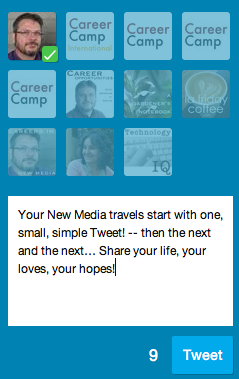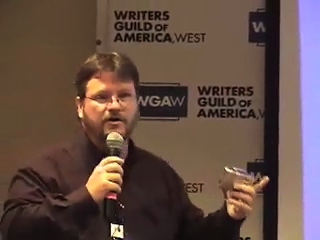It seems that every time I am at an event these days — Garden shows, Literacy Events, Business meetings — I am quickly pulled into a discussion of New Media/Social Media and how it can and should be used. almost universally, though, everyone I speak with is adrift in any new media plans. They might have a Twitter accounts, Facebook page or Instagram photos, but thy don’t know how or why they should be using them.
See more New Media Prescriptions here

It is easy to set up accounts, of course, so nearly everyone has done that. Then the accounts site there, empty, doing nothing for no one. They could, instead be spreading your message, talking to clients, selling your products 24/7, but leave them empty and they are worthless, if not outright damaging to you. If people find your accounts online, they expect to find something there and will be disappointed when there isn’t. Don’t disappoint your audience when it is so easy to feed them the information, the products, the content they desire.
In an effort to help you jumpstart your own usage of New Media, I present this selection of small, doable actions that you can take — every day — to start making New Media work for you. If you like these ideas, please consider scheduling a consult with me so that together we can craft a New Media plan that is customized to you and the needs of your life, business and products.
1. Start small
Select one online social media source and concentrate your actions there. Does your life lend itself to a more visual presentation, start with Instagram, Flickr or other photo sharing site. Set a goal to post 1 new item each day. It’s OK if you don’t make it every day, but try. In most cases, I think you will fin that you easily have at least 1 item to share per day, if not more. You just need to keep the thought in your mind throughout your day. If you do, you will be more inclined to capture those photos you may have simply walked by before.
2. Collect ideas
If you are like most people, you will easily have more than 1 item a day that you would like to share. If so, collect up these “extra” ideas in a list so that they are available when needed. Maybe you had a busy day and weren’t able to take that daily photo. No problem. Find one of your “extras” and post it today. Problem solved!
This same idea works with any sort of content. Write as many Twitter messages as you can. Take as many photographs as possible, Write articles for your blog when you are “in the zone.” Then you can easily have those off days without feeling like you have failed. You shouldn’t feel that way anyway when you miss a day, but I know from personal experience that those feelings can creep in sometimes and actually prevent you from posting in the future. Keep a ready supply of content at hand and you’ll never have to worry about content again.
Need examples of the type of info you can/should share? Need ideas of how you can use multiple sites. Check out my social media accounts below and use me as an example.
3. Expand to new services one by one
Once your feel you have your rhythm down with one service, consider adding another. In most cases, you will find this much easier than starting in the first place. If you are already taking photos for Instagram, those same photos can and should be easily be shared on Facebook, or as part of your blog or Google+ page. You have different audiences in each of those locations, so don’t worry about duplicating content. Sure, some folks may see the same post in 2 different locations, but many, many others will be seeing it for the first time.
As you add new services, you will start to develop a system for sharing your content. I have a list posted on my monitor to remind me of the places I need to share content so that I don’t forget. As it stands now, I have about 13 places I share each piece of content I create. These services ebb and flow as I discover which ones work best for me and I am constantly trying out new services as they are introduced. This might sound overwhelming, but on average it takes me maybe 5 mins to share new content to all of my other accounts now that I have my system in place. I don’t spend hours sharing on New Media and you don’t need to either.
For more on this idea, read my previous post, Benefiting from the “New Media Multiplier”
4. Produce your content and help your audience find you
I often hear from people that they can’t imagine who would be reading their content, listening to their podcast or looking at their photos. I know it sounds counterintuitive, but this isn’t your concern. Your audience will find you, no matter what, if you put your content out there. It is nearly impossible to know exactly who your audience is, but you must remember that everyone has an audience — they just need to find it.
Your job is to produce content and share it so that your audience can find you. Make it easy for them to stumble upon you through referrals from other web sites, search engines, friends, family and random synchronicity. This is the biggest reason why any of us share anything on our blogs or social media sites. It allows our audience to find us and share us with their audience — and so on, and so on, and so on!
Don’t worry about your audience. Worry about your work, your writing, your products, your promotion, your sharing. Do this and your audience will easily find you.
Getting started with New Media is equally the easiest and most difficult part of the process. It is easy to set up accounts, but it can be difficult to discover what you want and need to share there. This takes time and a bit of thought, but the advantages to be found in using New Media, whatever your goals far outweighs the difficulties. Get started today!
Great places to start your New Media journey. Pick one and get started! :
Need help jumpstarting your New Media usage? Ask your questions in the comments, email me at douglas@welchwrite.com or schedule a New Media Consult to help develop your own, unique New Media plans!




![Reblog this post [with Zemanta]](http://img.zemanta.com/reblog_e.png?x-id=80c9050b-7701-4e3b-9767-0414b2b3d51c)

